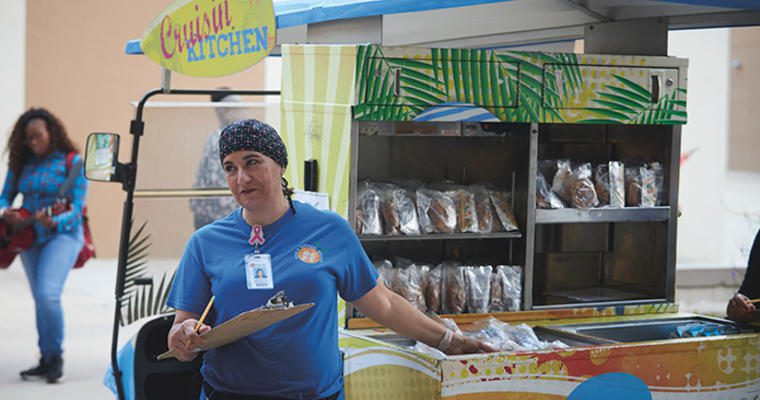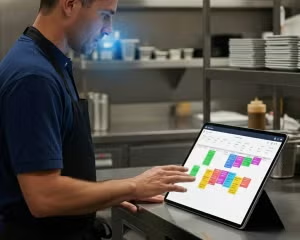As another school year begins, K-12 foodservice directors look for ways to be more efficient and grow sales. Four school districts have discovered ways that quick-serve meals—salad bars, grab-and-go selections and à la carte offerings—are a path to success.
A good time to implement the quick-serve model is the start of a new year, when students are anticipating new food offerings from school breakfast, lunch and snack programs. And during those first days of school, students don’t want to wait in long cafeteria lines. In fact, students never want to wait in line. They are eager to get in, get out and catch up with friends. Quick-serve gets them through the food line quickly, all while offering options that meet National School Lunch Program (NSLP) reimbursable meal rules.
Handled properly, there are even cost savings and other efficiencies. You may not need as many people on the serving line. Carefully measured participation levels can streamline ordering. And knowing how many servings you need each day can cut down on waste, allowing you to more easily monitor food safety.
Take a simple, affordable approach
Salad bars, breakfast bars, potato bars, taco bars and à la carte are not new. But many foodservice directors struggle with keeping them simple enough to fit their operation and attractive enough to increase participation.
At a suburban Chicago high school, Tina Mehta created quick-serve salads at each of her four serving lines. She purchased countertop Cambro units into which large, reusable ice-pack slabs could fit under the serving pans. The units cost about $500 each, she says, and the ice slabs spared the expense of buying an ice maker. Each night, she places the slabs in the freezer. The next day, they are frozen solid and hold temperature for six hours.
“We’ve had Health Department checkups every six months, and they’ve never had a problem holding temps for the six half-size hotel pans in each Cambro unit,” says Mehta, Foodservice Director at Lemont Township High School District 210.
The salad offering has been such a success, her $2,000 initial investment has resulted in about $70,000 more in sales. Mehta also has added a hot station, a cold station and a deli station since the initial salad bars. The popularity of the deli station—up from 35 meals to 125 meals over six months—has justified adding an employee for three hours a day at that station.
Be prepared to make changes
Starting simple is the recipe recommended by Austin Dacci, Foodservice Director at Harrison County Schools in Kentucky. He urges kitchen managers to observe quick-serve at other schools before implementing it in your own cafeteria. Once the decision has been made, he stresses patience.
“Don’t give up after the first week, because there might be a lot of waste or people might be abusing it,” he says. “There’s always some adjustment to your market.”
One way he addressed waste was to start his salad bar with boxed lettuce. Each container holds a romaine blend and enough hard-boiled egg to meet the NSLP protein requirement. That way, each container counts as a reimbursable meal as long as students select a roll and a beverage.
The students also can select from a variety of toppings: whole-grain pasta, vegetables, fruits and even proteins such as popcorn chicken, fajita-style chicken, diced turkey, diced ham and cheese.
For students who don’t choose salads, there’s a companion yogurt bar. Each package contains yogurt and enough granola that each box is a reimbursable meal. The fruits and other toppings are treated like condiments that encourage participation by offering variety.
The quick-serve line has bolstered participation by as much as 2 percent a day in the 850-student high school, Dacci says. “We’re making a little bit of money from the students, but it has greatly increased our teacher and staff participation.”
Minimize waste, maximize safety
At Noblesville Schools in Indiana, Assistant Nutrition and Foodservice Director Erin Brattain says one of the keys to success of her salad bar is eye appeal. Her quick-serve offering features lots of bright colors. “It looks very much like what you might see at a college level.”
Noblesville also packages lettuce in a container that students can take and top with other components. If students only top it with cheese and/or meat (plus the beverage component) it counts as a reimbursable meal. One of her challenges is maintaining a fresh appearance while also controlling food safety and preventing waste throughout four daily lunch periods.
Because she uses data that shows average salad sales, her team preps only about 20 extra lettuce containers daily. It’s harder to control waste with the salad toppings. By the time the fourth lunch period arrives, she doesn’t want students to be discouraged from choosing salads when only the dregs of cheese, meat or pepper bins remain. To limit waste, her staff adds enough of ingredients such as shredded cheese to provide a fresh appearance. That eliminates using an entire new container and creating waste. For safety, she puts fresh tongs in before the start of each lunch period.
The salad bar, she admits, is not a big moneymaker because students can load up on toppings. Instead, the salads are an attraction that brings students to the line where they might pick up a $2 drink or a slice of pizza to go with their salad.
The quick-serve model also is used at breakfast. Noblesville’s Brattain offers a hot entrée like breakfast sandwiches and other pre-wrapped options like granola bars that students can take and eat as they walk to their lockers. “We do a lot of grab-and-go in the mornings—we have kids come through and just buy two or three bottles of water to drink throughout the day,” she says. “We purposely price our beverages a little cheaper than the vending machines.”
Think beyond the salad bar
At Lincoln Park Middle School south of Detroit, Foodservice Director Mark Rodriguez used the construction of a new kitchen as his opportunity to implement four quick-serve lines. The result was a huge success.
Where he used to have food brought in from a satellite kitchen, he now has lines for pizza, burgers, deli and salad/parfait lunches. Participation went from 650 meals a day to more than 800.
The pizza line includes three choices daily—cheese only, cheese and pepperoni and a daily special. The burger line serves beef patties as well as chicken sandwiches. The deli line is his version of a Subway sandwich shop, with a variety of ingredients that can be made into sandwiches and wraps.
The salad/parfait line was a happy afterthought, built with material that remained after the construction. The line also offers premade, wrapped sandwiches, a quick-serve line for those who don’t want to wait if the other lines are long. He serves 65 salads a day. And, since every food item is packaged and date-stamped, he is able to keep it on the line for two days to prevent waste and make sure he always has enough for everyone.
“I never want to run out,” Rodriguez says. “I’m not a big fan of telling kids, ‘Sorry, that’s it.’ They are our customer and we have to do our best to accommodate what they are looking for.”
Quick-serve helps him, and other schools, achieve that objective.












